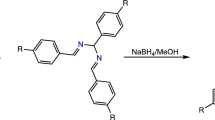Abstract
The hydrolysis, alcoholysis, and hydrazinolysis of N-phenacylpyridinium bromide lead to the corresponding benzoic acid derivatives. In addition, 3,6-diphenylpyridazine is formed during hydrazinolysis. The hydrolysis and alcoholysis of N-phenacylisoquinolinium bromide lead to its dimerization, whereas hydrazinolysis gives a triazinoisoquinoline derivative.
Similar content being viewed by others
Literature cited
F. Kröhnke, Angew. Chem., 65, 605 (1953).
C. Paal and H. Schulze, Ber., 33, 3789 (1900).
V. S. Garkush-Bozhko, O. P. Shvaika, L. M. Kapkan, and S. N. Baranov, Khim. Geterotsikl. Soedin., 961 (1974).
Author information
Authors and Affiliations
Additional information
Translated from Khimiya Geterotsiklicheskikh Soedinenii, No. 3, pp. 372–374, March, 1976.
Rights and permissions
About this article
Cite this article
Garkusha-Bozhko, V.S., Kochkanyan, R.O., Shvaika, O.P. et al. Reactions of pyridinium and isoquinolinium phenacylides with nucleophiles. Chem Heterocycl Compd 12, 317–319 (1976). https://doi.org/10.1007/BF00479573
Received:
Issue Date:
DOI: https://doi.org/10.1007/BF00479573




